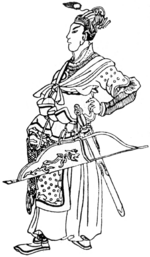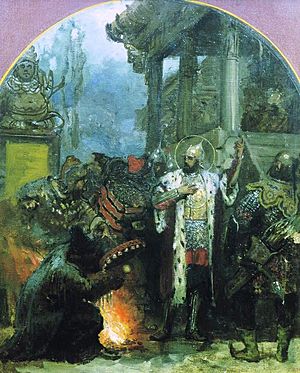Batu Khan facts for kids
Quick facts for kids ᠪᠠᠲᠤ ᠬᠠᠭᠠᠨÖgedei Khagan Batu |
|
|---|---|
| Khan | |
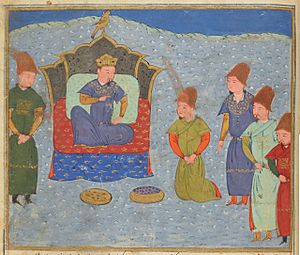
Batu depicted by Rashid al-Din
|
|
| Khan of the Golden Horde Western Half (Blue Horde) |
|
| Reign | 1227–1255 |
| Coronation | 1224/1225 or 1227 |
| Predecessor | Jochi |
| Successor | Sartak |
| Born | c. 1205 Khamag Mongol |
| Died | 1255 (aged 49–50) Sarai Batu, Golden Horde |
| Consort | Boraqchin Khatun |
| Issue | Sartak Toqoqan |
| House | Borjigin |
| Dynasty | Jochids |
| Father | Jochi |
| Mother | Ukhaa Ujin of the Onggirat |
| Religion | Tengrism |
Batu Khan (c. 1205 – 1255) was a powerful Mongol leader. He founded the Golden Horde, which was a big part of the Mongol Empire. Batu was the son of Jochi and the grandson of the famous Genghis Khan. His kingdom, called an ulus, ruled over areas like Kievan Rus', Volga Bulgaria, Cumania, and the Caucasus. This rule lasted for about 250 years.
Contents
Who was Batu Khan?
People described Batu Khan as kind to his own people. However, they also said he was very strict with them. He was known for being extremely fierce in battle. He was also very smart and clever when it came to war. This was because he had been fighting for a long time. One person who met him said he had a face covered with reddish spots.
Batu's Early Life and Rise to Power
After his father Jochi passed away, Genghis Khan gave Jochi's lands to his sons. Genghis Khan made Batu the leader, or Khan, of the Golden Horde. This area was also known as the Ulus of Jochi. Batu's older brother, Orda Khan, agreed that Batu should take their father's place.
When Genghis Khan died in 1227, he left 4,000 Mongol soldiers to Jochi's family. Jochi's lands were split between Batu and Orda. Orda's group, the White Horde, ruled the lands between the Volga river and Lake Balkhash. Batu's Golden Horde ruled the lands to the west of the Volga.
In 1229, Batu joined a big military campaign against the Jin dynasty in North China. At the same time, his younger brother was fighting tribes in the west. Even with strong resistance, the Mongols conquered major cities. They also made the Bashkirs their allies.
Conquering Kievan Rus'
In 1235, the Great Khan Ögedei ordered Batu to conquer lands to the west. Batu was given a huge army, possibly 130,000 soldiers. Many of his relatives and famous generals joined him. The army, led by Subutai, crossed the Volga river. They invaded Volga Bulgaria in 1236. It took them a year to defeat the people there.
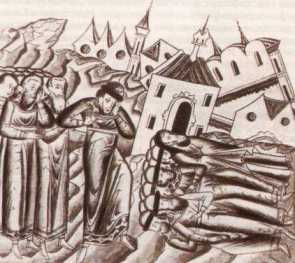
In November 1237, Batu Khan demanded that Yuri II of Vladimir-Suzdal surrender. When Yuri refused, the Mongols surrounded Ryazan. After six days of fierce fighting, the city was completely destroyed. Yuri II sent his sons to stop the Mongols, but they were defeated. The Mongols then burned Kolomna and Moscow. On February 4, 1238, they attacked the capital of Vladimir-Suzdal. Three days later, the city was captured and burned.
Batu Khan then divided his army into smaller groups. These groups attacked many Rus' cities. One of the hardest towns to capture was Kozelsk. Its young prince and people fought the Mongols for seven weeks. Only Smolensk, Novgorod, and Pskov escaped destruction. Smolensk surrendered and agreed to pay tribute. Novgorod and Pskov were too far away and protected by marshlands.

In the summer of 1238, Batu Khan also attacked the Crimea. He brought peace to Mordovia and the Kipchak lands. In the winter of 1239, he attacked Chernigov and Pereyaslav. After a long siege, the Mongols stormed Kiev in December 1240. Despite strong resistance, Batu Khan took the main cities of Halych and Volodymyr. The Rus' areas then became under the control of the Mongol Empire.
Invading Central Europe
Many Cuman people sought safety in the Kingdom of Hungary. Batu sent messengers to Béla IV, the King of Hungary, but they were all killed. Batu warned Béla that it would be hard for him to escape. Batu Khan then decided to push his armies as far as the ocean.

After attacking the Rus' lands, Subutai and Batu sent spies into Poland, Hungary, and Austria. This was to prepare for an attack into the heart of Europe. They planned their attack very carefully. Batu Khan was the main leader, but Subutai was the actual commander on the battlefield.
The Mongols invaded central Europe in three groups. One group attacked Poland and defeated a combined army at Legnica. Another group crossed the Carpathian Mountains. A third group followed the Danube river. The armies swept across Hungary. In the spring of 1242, they moved into Austria and Dalmatia.
In 1241, Batu's army defeated King Béla IV and his allies at the Battle of Mohi. The Mongols then appointed a governor in Hungary. They also made coins in the name of the Great Khan. Batu sent his general Khadan to chase Béla, who had fled to Croatia.
Batu demanded that Frederick II, the Holy Roman Emperor, give up his throne. The Emperor and Pope Gregory IX called for a crusade against the Mongols. But Europe was having its own problems.
By late 1241, Batu and Subutai were planning to invade Austria, Italy, and Germany. Then, news came that Ögedei Khan had died in December 1241. Batu wanted to keep fighting, but Subutai reminded him of the Mongol law. The Mongols pulled back in the spring of 1242. This was because the royal princes and Subutai were called back to Karakorum for a meeting to choose the next Great Khan. Batu was a possible choice for Great Khan. But when he didn't get the title, he focused on strengthening his rule in Asia and the Urals.
Batu's Influence and Challenges
After leaving Hungary, Batu set up his camps along the Volga river. When the Great Khatun Töregene asked him to help choose the next Mongol Emperor, Batu said he couldn't attend. This delayed the choice for several years. Eventually, Güyük was chosen as Khagan in 1246. Batu's brothers represented his family at this event.
As one of the oldest grandsons of Genghis Khan, Batu became a very important leader. He oversaw all the western parts of the Mongol Empire. He managed affairs among the Russian princes. He also appointed governors in Iran and met with important people from the Caucasus. However, he never openly challenged the Great Khan's power.
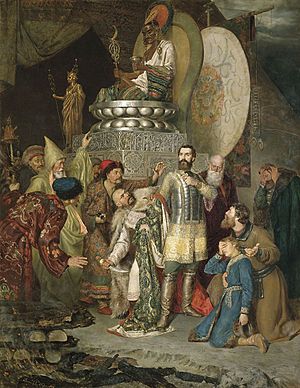
When Batu returned, he called the Grand Prince Yaroslav II of Vladimir to meet him. Batu welcomed Yaroslav and confirmed him as the main ruler over the other Russian princes. Batu sent Yaroslav to the imperial court in Karakorum for Güyük Khan's inauguration in 1246. Sadly, Yaroslav died in Mongolia around that time.
Another prince, Michael of Chernigov, had killed a Mongol messenger. When Michael came to Batu, he was told to follow a Mongol custom. Michael refused to follow this custom, and because of this, Batu ordered him to be killed.
Danylo of Halych came to Batu and showed respect. Batu praised him for his obedience. After the defeat of the Sultanate of Rum, Batu also helped settle disputes among leaders from Georgia and Armenia.
There was growing tension between Batu and Güyük. Güyük started replacing officials in Iran and the Caucasus with his own people. When Güyük began moving west, Batu was warned that Güyük was coming for him. Batu moved slowly. Before meeting Batu, Güyük died suddenly. Some sources suggest that one of Batu's brothers might have killed Güyük.
Batu and Möngke Khan
Batu saw a chance to remove the family of Ögedei from leading the Mongols. Batu called a meeting, a kurultai, in his own territory in 1250. Members of other Mongol families refused to come. The meeting offered the throne to Batu Khan, but he wasn't interested in becoming the new Grand Khan. Instead, he suggested Möngke Khan, who had led a Mongol army in Russia.
Batu sent Möngke to a formal kurultai in the Mongol heartland. Möngke's supporters invited other princes, but they refused to attend. They insisted that only Ögedei's descendants should be Khan. In response, Batu accused them of plotting against him. After the meeting, Möngke was declared Great Khan of the Mongol Empire in 1251. He punished the families who had opposed him.
Prince Andrey II allied with rebellious princes in western Rus'. Batu sent a military force. Andrey fled to Sweden. The Mongols punished the people in Vladimir. Thanks to his friendship with Batu's son Sartaq, Alexander Nevsky became the Grand Prince of Vladimir in 1252.
During Möngke's rule, Batu's importance as a kingmaker and a powerful leader in the west reached its peak. Batu allowed Möngke's census takers to work freely in his lands. Batu, Möngke, and other royal families shared rule over a vast area. Batu left the affairs of his kingdom to his son, Sartaq, before he died in 1255.
Batu Khan's Family and What He Left Behind
Batu Khan was about five feet and seven inches tall. He had at least four children:
- Sartaq, who was Khan of the Golden Horde from 1255 to 1256. His mother was Boraqchin.
- Toqoqan
- Andewan
- Ulagchi
Batu's mother was from the Mongol Onggirat clan. His main wife, Boraqchin, was from the Alchi-Tatar group.
After Batu and his son Sartaq died, Batu's brother Berke took over the Golden Horde. Berke was not as interested in staying united with his Mongol cousins. He even went to war with Hulagu Khan. However, Berke officially recognized Möngke as his overlord. Berke acted as an independent ruler. He did not share Batu's interest in conquering more of Europe.
The Kipchak Khanate was known in Rus' and Europe as the Golden Horde. Some people think this name came from the golden color of the Khan's tent. The word "Horde" comes from the Mongol word "orda" or "camp." "Golden" might have meant "royal camp." Of all the Mongol kingdoms, the Golden Horde ruled for the longest time. Batu Khan's family ruled the Jochid Ulus until 1360. Later, descendants of his brothers took the throne of the Golden Horde.
Ancestry
| Ancestors of Batu Khan | ||||||||||||||||||||||||||||||||||||||||||||||||||||||||||||||||||||||||||||||||||||||||||||||||||||||||||||||||||||||||||||||||||||||||||||||||||||||||||||||||||||||||||||||||||||||||||||||||||||||||||||||||||||||||||||||||||||||
|---|---|---|---|---|---|---|---|---|---|---|---|---|---|---|---|---|---|---|---|---|---|---|---|---|---|---|---|---|---|---|---|---|---|---|---|---|---|---|---|---|---|---|---|---|---|---|---|---|---|---|---|---|---|---|---|---|---|---|---|---|---|---|---|---|---|---|---|---|---|---|---|---|---|---|---|---|---|---|---|---|---|---|---|---|---|---|---|---|---|---|---|---|---|---|---|---|---|---|---|---|---|---|---|---|---|---|---|---|---|---|---|---|---|---|---|---|---|---|---|---|---|---|---|---|---|---|---|---|---|---|---|---|---|---|---|---|---|---|---|---|---|---|---|---|---|---|---|---|---|---|---|---|---|---|---|---|---|---|---|---|---|---|---|---|---|---|---|---|---|---|---|---|---|---|---|---|---|---|---|---|---|---|---|---|---|---|---|---|---|---|---|---|---|---|---|---|---|---|---|---|---|---|---|---|---|---|---|---|---|---|---|---|---|---|---|---|---|---|---|---|---|---|---|---|---|---|---|---|---|---|
|
||||||||||||||||||||||||||||||||||||||||||||||||||||||||||||||||||||||||||||||||||||||||||||||||||||||||||||||||||||||||||||||||||||||||||||||||||||||||||||||||||||||||||||||||||||||||||||||||||||||||||||||||||||||||||||||||||||||
|
See also
 In Spanish: Batú Kan para niños
In Spanish: Batú Kan para niños
- List of Khans of the Golden Horde


